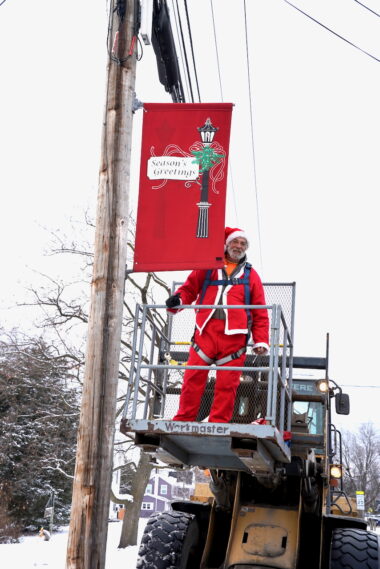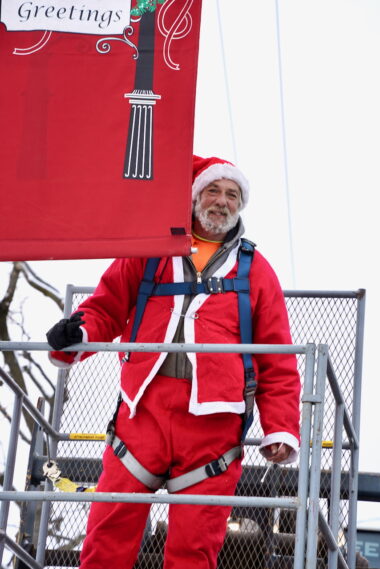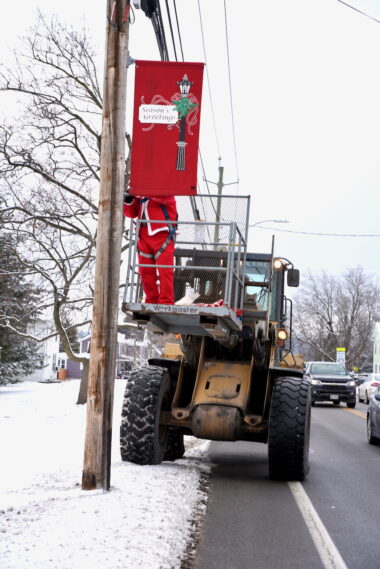 December 11, 2:30 pm, Meadowbrook Healthcare, 154 Prospect Avenue, Plattsburgh. A Photo Peek at Old Plattsburgh. Using photos from the CCHA collection, see ‘then and now’ photo comparisons of landmarks in downtown Plattsburgh. Come and see what you might recognize and share stories of these special spots.
December 11, 2:30 pm, Meadowbrook Healthcare, 154 Prospect Avenue, Plattsburgh. A Photo Peek at Old Plattsburgh. Using photos from the CCHA collection, see ‘then and now’ photo comparisons of landmarks in downtown Plattsburgh. Come and see what you might recognize and share stories of these special spots.
December 11, 6:00 pm, Clinton County Historical Association 98 Ohio Avenue, Plattsburgh. Introducing the newly published book The Champlain Canal: 200 Years of Change with Matt Harrison. This book features chapters by historians, archeologists, and biologists on the past and present evolutions of the Champlain Canal which celebrated its bicentennial in 2023. Harrison’s talk will focus on early tourism on the waters of the canal and on Lake Champlain, in particular the accounts of two women travelers who recorded their vacations along the canal in the 1890s — Florence Snedeker and Augusta Brown.
December 13 – 14, 10 am to 3 pm, Clinton County Historical Association, 98 Ohio Avenue, Plattsburgh. Annual Holiday Open House. See our newest exhibits: The Wedding Gowns, the Military Gallery featuring a timeline of the military presence in the North Country and Pathway to America250 about the Revolutionary War in the Champlain Valley. Select some gifts from the largest collection of North Country history books north of Albany. The winner of our lottery board will be drawn at 3 pm on 14 December. Still time to purchase tickets!
December 31, 1:00 pm, Christ & St. John’s Episcopal Church, 18 Butternut Street, Champlain, “Struggle in the Snow: The Storming of Quebec” with Thaddeus Booth-Trudo. On New Years Eve 2025 the Clinton County Historical Association and the Clinton County America 250 Committee will commemorate the service, sacrifice, and many historical firsts of the approximately 10,000 American troops of the Continental Army that served as part of the 1775-1776 Quebec Campaign. This commemoration is being held on New Year’s Eve as it is the 250th Anniversary of the attempted Storming of Quebec City by American forces under the command of Generals Richard Montgomery and Benedict Arnold. This storming attempt marked the high water mark of the campaign and we feel it appropriate to commemorate those that served during this campaign on this anniversary.
Please contact Helen Nerska, Director, Clinton County Historical Association for more information.
Posted: December 5th, 2025 under Adirondack Region News, Arts and Entertainment, Community Events, Northern NY News, Peru/Regional History.
Comments: none
Albany, News Release of Dec. 4, 2025 Governor Kathy Hochul today signed legislation to make life-saving medical care more affordable and accessible for New Yorkers. Legislation S2000A/A1195A requires health insurance policies to provide coverage for follow-up screening or diagnostic services for lung cancer, and prevents insurance policies from imposing cost-sharing for those services. The legislation builds on the Governor’s affordability agenda, which includes a ban on co-pays for critical medications like insulin and inhalers.
“Lung cancer is one of the deadliest cancers in the nation, and the last thing a patient should have to worry about is out-of-pocket costs for critical follow-up screenings,” Governor Hochul said. “Signing this legislation means that thousands of New Yorkers can focus on what is truly important: their health and well-being. With this law, New York is making clear that no one should face financial barriers to getting the care they need.”
Lung cancer remains the leading cause of cancer deaths statewide. Each year approximately 13,900 New Yorkers are diagnosed with lung cancer and about 7,400 die from this disease.
New York State Department of Financial Services Acting Superintendent Kaitlin Asrow said, “By removing out-of-pocket costs for lung cancer screenings, Governor Hochul and the New York State Legislature have improved the chances that this form of cancer will be detected and treated as early as possible.
Posted: December 5th, 2025 under Business News, Heathcare News, State Government News, State Legislator News, Statewide News.
Comments: none
 Call Meeting to Order
Call Meeting to Order- Pledge of Allegiance
- Roll Call
- MOTION/DISCUSSION: To Accept Reports from all Departments: (Water/Sewer/Valcour; Highway; Town Clerk; Dog Control; Youth Department; Code/Zoning; Supervisor’s Report; Court; Website; Banking Reports, and JCEO);
- MOTION: Acceptance of Minutes for the Regular Meeting of November 24, 2025
- Community Input.
- DISCUSSION/MOTION: Approval of Luck Brothers Application for Payment #1 for Fuller Rd. Culvert Project.
- RESOLUTION/DISCUSSION: Approval to Order New 2027 Western Star 47 X Chassis with Viking Plow Gear
- RESOLUTION/DISCUSSION: Approval of C & S Companies to Place the Telegraph Rd over Dry Mill Brook Culvert Project Out for Bid With a Bid Opening Date of January 7, 2026
- DISCUSSION/MOTION: Approval of John W. Danforth Company Pay App. #5 for Peru WWTP Project.
- DISCUSSION/MOTION: Approval of Murnane Building Contractors Pay App. #5 for Peru WWTP Project.
- RESOLUTION/DISCUSSION: To Appoint Sarah Mitchell to Fill the Remaining Term for Town Justice.
- DISCUSSION: Other Business: Council Comments
- DISCUSSION: Other Business: Department Head Comments.
- DISCUSSION: Public Comments on Agenda Items Only.
- RESOLUTION/DISCUSSION: Pay November 2025 Bills.
- MOTION: Adjourn to Executive Session.
- MOTION: Return from Executive Session.
- MOTION: Adjourn Meeting.
Posted: December 5th, 2025 under Adirondack Region News, Community Events, General News, Northern NY News, Peru News, Town Board News.
Comments: none
As of February 1, 2026, the TSA will charge a $45 fee for travelers without a REAL ID or another acceptable ID (like a passport) to use their alternative identity verification system, TSA Confirm.ID, for a 10-day travel period, encouraging travelers to get their REAL ID from their state DMV before flying.
What this means for travelers:
If you have a REAL ID or Passport: No change, just present it as usual.
If you don’t have a REAL ID/Passport: You’ll need to pay $45 for a temporary pass (TSA Confirm.ID) to verify your identity at the checkpoint.
Payment: The fee can be paid online beforehand or at the airport, and it covers 10 days of travel.
Purpose: This new fee and system aim to ensure everyone passing through security is verified, with the TSA urging people to get their REAL ID now to avoid fees and delays.
Posted: December 5th, 2025 under Border News, Law Enforcement News, National History, National News, Peru/Regional History.
Comments: none
Posted: December 5th, 2025 under Adirondack Region News, Business News, Corruption in Gov't., Environmental News, Lake Champlain News, Law Enforcement News, National History, National News, Northern NY News, Political News.
Comments: none
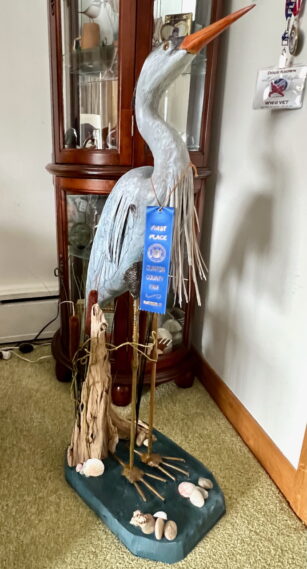
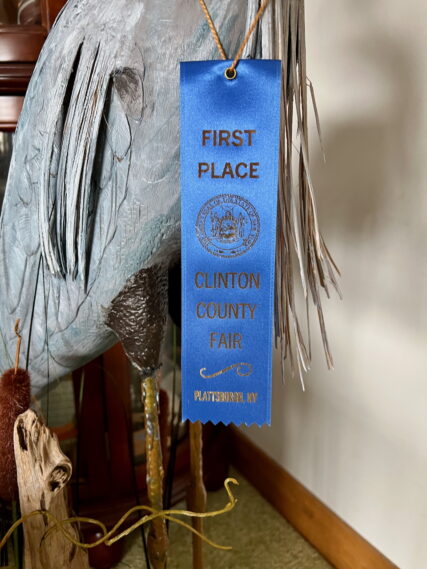
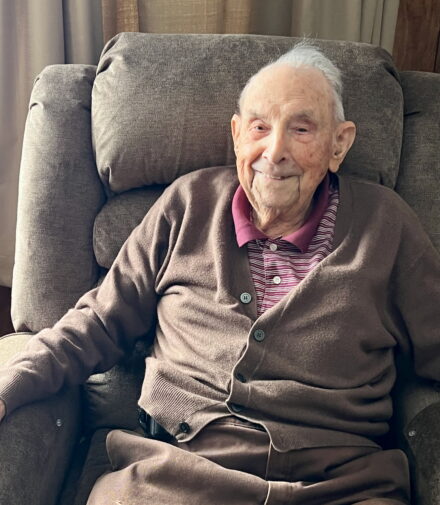
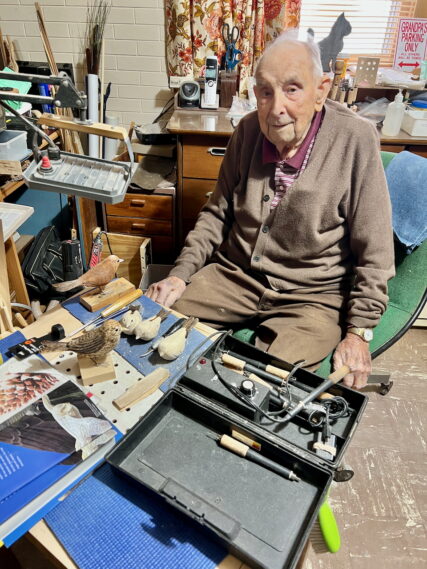 By John T Ryan
By John T Ryan
Doug Brown has a big birthday coming up on December 31, Birthday #105. Tomorrow, Friday, December 5, will also be a big day for Doug; he’ll be leading the Peru Tractor Parade as its Grand Marshal. Most people know Doug as the longtime owner of Peru Hardware, a rural mail carrier, and a World War II Veteran.
Your reporter pleads guilty to not having visited Doug since I wrote a story about him two years ago. Today, I found him almost as active as before, with one notable exception, he no longer drives. He commented, “I have heart trouble, so my doctor doesn’t want me to drive anymore.” Fortunately, Doug’s daughter, Wendy Silverman, and her husband, Bob, live nearby and are available to assist him whenever needed.
Bird carving is still Doug’s favorite pastime. A beautifully carved heron proudly displayed in his living room features a First Place ribbon hanging from its neck, a testament to his craftsmanship that earned him the award at the Clinton County Fair last summer. Before I left, he eagerly showed me the birds he was currently working on in his workshop. He pointed to one in particular, mentioning that he was redoing it because he wasn’t satisfied with how he had painted it.
When I asked Doug two years ago what the secret to his long life was, he replied, “I’m always looking, thinking ten years ahead at things I want to do. So I keep busy all the time. That’s the only thing.” Today, while he may not be looking ten years into the future, he is certainly staying busy and looking great.
Be sure to give Grand Marshal Doug Brown a big wave on Friday when his daughters, Wendy and Gail, transport him as Grand Marshal in the Peru Tractor Parade!
Click here to read the Peru Gazette’s January 24, 2013 story on Doug Brown.
Click here to read a Peru Gazette story on Doug Brown’s military service and participation in a June 2013 North Country Honor Flight.
12/4/25, 7:15 p.m. Spelling of “Wendy” and “notable” corrected.
Posted: December 4th, 2025 under Adirondack Region News, Agricultural News, Business News, Community Events, Faces of Peru, General News, Honor Flights, Northern NY News, Peru News, Peru resident news/accomplishments, Peru/Regional History, Senior Citizen News, Veterans' News.
Comments: none
 By John T Ryan
By John T Ryan
Highlights of Peru Town Board Meeting of November 24, 2025
Highway Superintendent Michael Farrell said the town should be advertising for bids on the Telegraph Road culvert project in either December or January. Farrell hopes work will start soon after the town awards the contract.
Town of Plattsburgh Zoning/Codes Officer Steve Imhoff is acting as Peru’s Zoning/Codes Officer until the town fills the open position. The town advertised the position online on ZipRecruiter.com
The Board approved:
Requesting NYS to reduce the speed limit on the Fox Farm Road.
Amending the Town Court’s Justice Court Assistance Program (JCAP) grant application amount from $ 5,000 to $8,000. The grant monies will fund courthouse security equipment and enhance online capabilities.
Hiring Brooks Investigations LLC to provide a security officer at $75 hourly whenever the Clinton County District Attorney (DA) staff is presenting cases. The DA’s staff usually appears for 4 hours twice a month.
Reimbursing $406.20 to a resident for home damage incurred as a result of a sewer line backup.
Compensating Justice Scott Thurber for picking up Justice Jim Kirby’s caseload. The compensation will equal what the late Justice Kirby would have received. Town Justice Elect Sarah Mitchell will take office in January.
Click here to view the Peru Gazette’s Meeting Video
Posted: December 4th, 2025 under Adirondack Region News, Code Enforcement, County Government News, General News, Law Enforcement News, Northern NY News, Peru News, Town Board News.
Comments: none
 The 2025 Peru Tractor Parade will be held on Friday, December 5 beginning at 6:15 to 6:30 PM. 105-year-old Doug Brown will be the Grand Marshal. Make plans now! The Tractor Parade is one of Peru’s special events. At 5:30 PM retiring town councilman Jim Douglass will light the town’s Christmas Tree at the Little Ausable River Park Gazebo.
The 2025 Peru Tractor Parade will be held on Friday, December 5 beginning at 6:15 to 6:30 PM. 105-year-old Doug Brown will be the Grand Marshal. Make plans now! The Tractor Parade is one of Peru’s special events. At 5:30 PM retiring town councilman Jim Douglass will light the town’s Christmas Tree at the Little Ausable River Park Gazebo.
The parade starts at the Irwin farm on Jarvis Road, left on River Rd., right on Laflure Lane, right onto Rt. 22, right over the bridge, right at Liberty’s on Union Rd., left on Cross St, left onto Route 22, back over the bridge to Stewart’s, left on Holden Ave, left on School Street to 22, and done.
Posted: December 4th, 2025 under Adirondack Region News, Agricultural News, Community Events, Faces of Peru, Northern NY News, Peru News.
Comments: none
News Release, December 3, 2025 – Funds Assist with Purchases of Wildland Firefighting Equipment for Rural Fire Departments
The New York State Department of Environmental Conservation (DEC) is now accepting applications for $851,255 in Volunteer Fire Capacity grants to help rural fire departments protect public safety and natural resources. The application deadline is December 22, 2025.
“Volunteer fire departments are essential partners with DEC Forest Rangers in battling wildfires across the state,” said DEC Commissioner Amanda Lefton. “The Volunteer Fire Capacity grant program helps support fire personnel in these departments with the resources they need to continue the vital work protecting our communities and State lands.”
The Volunteer Fire Capacity grant program is funded by the U.S. Forest Service and administered by DEC’s Division of Forest Protection. Eligible fire departments will receive 50/50 matching funds up to $3,500, a $1,000 increase from last year. In 2024, the program provided grants to 345 fire departments.
Eligible fire departments include those that are at least 80 percent volunteer and provide wildland fire protection to a rural area within their jurisdiction. Fire departments that receive a grant award must complete all grant process paperwork.
Only expenses directly related to wildland firefighting suppression efforts are eligible for funding. These include the purchase of protective fire clothing and PPE, modern communications supplies for more effective action on incidents, firefighting supplies such as nozzles and hoses, tools and other smaller scale supplies, and water delivery systems such as cisterns and dry hydrants.
Expenditures not directly related to firefighting, such as search and rescue supplies, acquisition of land, construction of buildings and facilities, major apparatus purchases, and maintenance items (gas/gas cans, oil, bar chain oil) are not eligible for funding.
For applications and additional information about the grant program, contact DEC at (518) 402-8839, or write to NYSDEC, Division of Forest Protection, 625 Broadway 11th Floor, Albany, NY 12233-2560, or visit the DEC website.
Posted: December 4th, 2025 under Adirondack Region News, Environmental News, Fire Department News, Law Enforcement News, State Government News.
Comments: none
| News Release, Dec. 3, 2025, WASHINGTON, D.C. – Today Congresswoman Elise Stefanik (R-NY), Chair of House Republican Leadership, announced the Northern Border Regional Commission (NBRC) has awarded more than $5.5 million in funding for projects across Upstate New York and the North Country, including investments in rural hospitals, school districts, and veterans.
“I’m proud to deliver more than $5.5 million in NBRC funding to complete critical projects that will drive economic growth and strengthen communities across the North Country. Investing in our region has always been one of my top priorities in Congress, and this funding is another major win for New York families, school districts, rural hospitals, and veterans. I look forward to building on this momentum and advancing NBRC initiatives that improve rural healthcare, expand opportunity, and create new jobs for New Yorkers,” said Stefanik.
Grant awardees include:
Saranac Central School District
- $1,000,000.00 to expand early childhood education services across Clinton and Essex Counties
State University of New York College of Technology at Canton
- $1,000,000.00 to address critical childcare shortages and support workforce development in St. Lawrence County
Paul Smith’s College of Arts and Sciences
- $999,991.01 to launch the Troops to Timber program, which will train veterans in collaboration with Fort Drum and transition servicemembers for careers in forestry and logging
Hudson Headwaters Health Network
- $856,724.00 to construct a new dental facility in Ticonderoga to serve 1,550 additional patients annually
St. Lawrence County Industrial Development Agency
- $500,000.00 to establish a purification pilot facility for Empire State Mines’ new graphite processing operation and advance critical mineral supply chains.
Warren County, New York
- $231,680.00 to support environmental education, youth engagement, and the $100 million sportfishing economy in the region
Adirondack Economic Development Corporation
- $197,192.00 to launch a nonprofit business acceleration program across 13 rural counties in Northern New York
Village of Newport
- $100,000.00 to help expand Newport’s municipal wastewater system
Adirondack Recreational Trail Advocates
- $99,001.92 to support tourism, transportation, and outdoor recreation infrastructure
Town of Moriah
- $66,940.00 to update Moriah’s Economic Development Plan and guide investment over the next five years
North Country Community College
- $52,750.00 to support environmental science, recreation, and arts programming for students and the community
|
|
Posted: December 4th, 2025 under Adirondack Region News, Business News, Congressional News, Education News, Northern NY News, Political News.
Comments: none
Ambition and a passion for discovery lead a first-generation student to Dartmouth
Click here for the VTDigger story
Posted: December 4th, 2025 under Education News, Regional NY-VT News, Social Issues.
Comments: none
Town of Bolton
Warren County
Wilderness Rescue: On November 29 at 7:55 p.m., Ray Brook Dispatch received a call from Warren County 911 about a hiker with chest pains approximately 1.5 miles in from the Clay Meadow trailhead in the Lake George Wild Forest. Four Forest Rangers and the Bolton Fire Department reached the 56-year-old from Gansevoort, made a health assessment, and determined a carry out was necessary. Rescuers used a wheeled litter to transport the hiker to the trailhead where they turned over care to Bolton EMS. Resources were clear at 10:10 p.m.
Clay meadow rescue
Clay Meadow rescue
Town of Lake George
Warren County
Public Outreach: On November 29, Forest Rangers participated in Lake George’s annual Lite Up the Village celebration. An inflatable Smokey Bear on loan from the Northeastern Forest Fire Protection Compact traveled with a decked-out Ranger engine brush truck.
Lake George’s Lite Up the Village
Town of Hadley
Saratoga County
Wilderness Rescue: On November 28 at 12:54 p.m., Forest Rangers Carabetta and Clute responded to a call for a hiker with a wrist injury on Hadley Mountain. The Saratoga County Sheriff’s Office, Hadley-Luzerne Fire Department, and Rockwell Falls Emergency Medical Services (EMS) also responded. By 2:40 p.m., rescuers reached the 55-year-old from Maryland approximately 0.75 miles up the trail. The hiker slipped and fell on their mountain descent. Rangers provided microspikes and trekking poles due to the icy trail conditions. They reached the trailhead at 3 p.m. Rockwell Falls EMS transported the patient to the hospital.
 |
Hadley Rescu
Posted: December 3rd, 2025 under Adirondack Region News, Law Enforcement News, Northern NY News, State Government News, Upstate New York.
Comments: none
 December 11, 2:30 pm, Meadowbrook Healthcare, 154 Prospect Avenue, Plattsburgh. A Photo Peek at Old Plattsburgh. Using photos from the CCHA collection, see ‘then and now’ photo comparisons of landmarks in downtown Plattsburgh. Come and see what you might recognize and share stories of these special spots.
December 11, 2:30 pm, Meadowbrook Healthcare, 154 Prospect Avenue, Plattsburgh. A Photo Peek at Old Plattsburgh. Using photos from the CCHA collection, see ‘then and now’ photo comparisons of landmarks in downtown Plattsburgh. Come and see what you might recognize and share stories of these special spots.
 Call Meeting to Order
Call Meeting to Order


 By John T Ryan
By John T Ryan By John T Ryan
By John T Ryan The 2025 Peru Tractor Parade will be held on Friday, December 5 beginning at 6:15 to 6:30 PM. 105-year-old Doug Brown will be the Grand Marshal. Make plans now! The Tractor Parade is one of Peru’s special events. At 5:30 PM retiring town councilman Jim Douglass will light the town’s Christmas Tree at the Little Ausable River Park Gazebo.
The 2025 Peru Tractor Parade will be held on Friday, December 5 beginning at 6:15 to 6:30 PM. 105-year-old Doug Brown will be the Grand Marshal. Make plans now! The Tractor Parade is one of Peru’s special events. At 5:30 PM retiring town councilman Jim Douglass will light the town’s Christmas Tree at the Little Ausable River Park Gazebo. 



